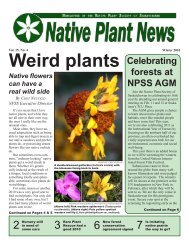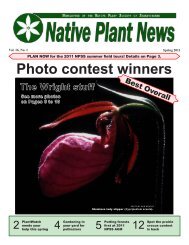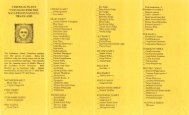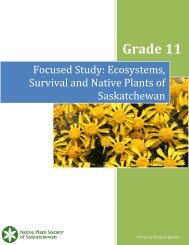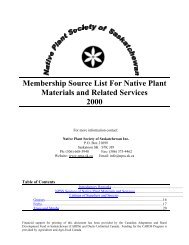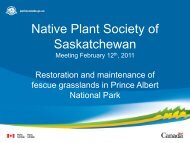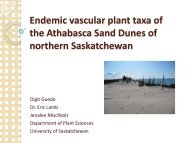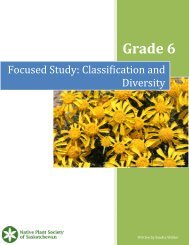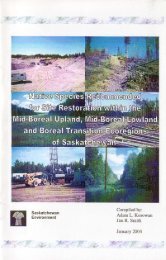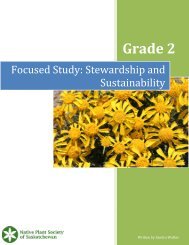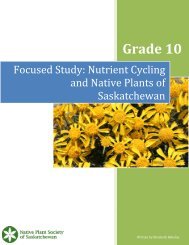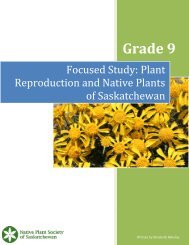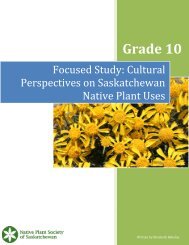Native Plants As Habitat For Wildlife - Native Plant Society of ...
Native Plants As Habitat For Wildlife - Native Plant Society of ...
Native Plants As Habitat For Wildlife - Native Plant Society of ...
Create successful ePaper yourself
Turn your PDF publications into a flip-book with our unique Google optimized e-Paper software.
Rare <strong>Plant</strong> Conservation in Important Bird Areas - Where is the Common Ground<br />
Josef K. Schmutz<br />
Community Conservation Planner, Important Bird Areas Program/ Nature Saskatchewan<br />
In the Important Bird Area (IBA) Program, special areas are awarded an Important Bird<br />
Area designation for conservation purposes if the areas are used by large concentrations<br />
<strong>of</strong> birds, if birds present are at risk, or if the sites represent intact biomes and their natural<br />
bird inhabitants with restricted ranges.<br />
The IBA Program was launched initially by BirdLife International in the UK. Today<br />
there are BirdLife Partners in over 100 countries. In Canada the national partners are the<br />
Canadian Nature Federation and Bird Studies Canada. In Saskatchewan, the<br />
conservation component <strong>of</strong> this program is being delivered by Nature Saskatchewan.<br />
Funding partners <strong>of</strong> the Community Conservation Plan for Chaplin, Old Wives and Reed<br />
lakes include Canadian Adaptation and Rural Development Saskatchewan (CARDS), the<br />
University <strong>of</strong> Saskatchewan, Saskatchewan Environment and Resource Management<br />
(SERM) and the Canadian Millennium Partnership Program.<br />
Nature Saskatchewan is working with the Canadian Nature Federation and Bird Studies<br />
Canada to deliver the conservation planning component <strong>of</strong> this program in Saskatchewan.<br />
IBA Saskatchewan was launched on 1 February 1999. At the inaugural IBA-<br />
Saskatchewan workshop held in Saskatoon on 22 October 1997, 123 candidate areas<br />
were nominated by several dozen naturalists. Data compilation and assessment by<br />
outside reviewers is now completed, yielding 53 IB<strong>As</strong> approved by Bird Studies Canada.<br />
The number <strong>of</strong> approved IB<strong>As</strong> may yet grow as more information becomes available,<br />
particularly in the north. However, current IBA priorities involve conservation planning<br />
and implementation <strong>of</strong> suggested actions. The 13 sites shown below have conservation<br />
plans completed or in various stages <strong>of</strong> completion. The program takes an ecosystem<br />
view to conservation, and seeks to combine sustainability with bird protection.<br />
Two <strong>of</strong> the 13 sites focus on grasslands (Govenlock, Nashlyn and Battle Creek IBA, and<br />
Colgate IBA), one on a marsh-lake-upland complex (Cumberland Marshes IBA), and the<br />
remainder on water bodies. <strong>For</strong> lake IB<strong>As</strong> the adjacent upland is usually equally if not<br />
more important in the ecology <strong>of</strong> IBA birds. In some cases the IBA has been expanded to<br />
include the entire watershed (Redberry Lake, and Chaplin, Old Wives and Reed lakes) or<br />
portions <strong>of</strong> watersheds.<br />
22



